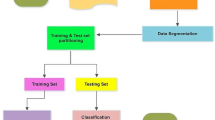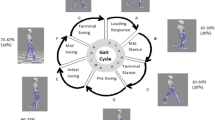Abstract
Neurophysiological signals are manifestations of the underlying brain activity, and they contain an abundance of neural information. The decoding and understanding of these signals is useful to develop robotic exoskeletons, benefitting device-aided motor rehabilitation. To this date, numerous efforts have been carried out to explore the relations between neurophysiological signals and locomotor capacity. Most of these studies focused on a single modality of neurophysiological signal and ignored its multiple modalities. In this study, the modalities from two kinds of biosensors were fused [electroencephalogram (EEG) and electromyogram (EMG)], and a novel deep learning model was proposed (multi-scale learning, MSL) to classify four walking patterns. The EEG and EMG data were collected during a walking experiment, where different walking conditions with and without exoskeleton-aided assistance were implemented (i.e. free-walking and exoskeleton-aided walking at zero, low, and high assistive forces). The performance achieved by the MSL model was compared to that of existing models, and the results show that multimodal MSL achieved the highest performance in terms of classification accuracy (89.33%). Moreover, the comparisons in our study show that an improved classification performance was obtained when a full 62-channel EEG setting was used compared to using a subset of 20 channels located on the sensorimotor region. This work contributes to the improvement of neurophysiological signal decoding and promotes the development of rehabilitation technologies as well as exoskeleton-aided applications.











Similar content being viewed by others
References
Ren WJ, Han M (2019) Classification of EEG signals using hybrid feature extraction and ensemble extreme learning machine. Neural Process Lett 50(2):1281–1301
Xi XG, Yang C, Shi JH, Luo ZZ, Zhao YB (2019) Surface electromyography-based daily activity recognition using wavelet coherence coefficient and support vector machine. Neural Process Lett 50(3):2265–2280
Young AJ, Ferris DP (2017) State of the art and future directions for lower limb robotic exoskeletons. IEEE Trans Neural Syst Rehabil Eng 25(2):171–182
Gordleeva SY, Lobov SA, Grigorev NA, Savosenkov AO, Shamshin MO, Lukoyanov MV, Khoruzhko MA, Kazantsev VB (2020) Real-time EEG-EMG human-machine interface-based control system for a lower-limb exoskeleton. IEEE Access 8:84070–84081
Ma J, Zhang Y, Cichocki A, Matsuno F (2014) A novel EOG/EEG hybrid human-machine interface adopting eye movements and ERPs: application to robot control. IEEE Trans Biomed Eng 62(3):876–889
Rashed-Al-Mahfuz M, Moni MA, Uddin S, Alyami SA, Summers MA, Eapen V (2021) A deep convolutional neural network method to detect seizures and characteristic frequencies using epileptic electroencephalogram (eeg) data. IEEE J Transl Eng Health Med 9:2000112–2000112
Amiri S, Fazel-Rezai R, Asadpour V (2013) A review of hybrid brain-computer interface systems. Adv Hum Comput Interact 2013
Giraudet L, Imbert J-P, Berenger M, Tremblay S, Causse M (2015) The neuroergonomic evaluation of human machine interface design in air traffic control using behavioral and EEG/ERP measures. Behav Brain Res 294:246–253
da Silva-Sauer L, Valero-Aguayo L, de la Torre-Luque A, Ron-Angevin R, Varona-Moya S (2016) Concentration on performance with p300-based BCI systems: a matter of interface features. Appl Ergon 52:325–332
Cho H, Ahn M, Ahn S, Kwon M, Jun SC (2017) EEG datasets for motor imagery brain-computer interface. GigaScience 6(7):gix034
Ramoser H, Muller-Gerking J, Pfurtscheller G (2000) Optimal spatial filtering of single trial EEG during imagined hand movement. IEEE Trans Rehabil Eng 8(4):441–446
Wold S, Esbensen K, Geladi P (1987) Principal component analysis. Chemometr Intell Lab Syst 2(1–3):37–52
Comon P (1994) Independent component analysis, a new concept? Signal Process 36(3):287–314
Phinyomark A, Phukpattaranont P, Limsakul C (2012) Feature reduction and selection for EMG signal classification. J Expert Syst Appl 39(8):7420–7431
Phinyomark A, Quaine F, Charbonnier S, Serviere C, Tarpin-Bernard F, Laurillau Y (2013) EMG feature evaluation for improving myoelectric pattern recognition robustness. Expert Syst Appl 40(12):4832–4840
Wang H, Zhang L, Yao LX (2021) Application of genetic algorithm based support vector machine in selection of new EEG rhythms for drowsiness detection. Expert Syst Appl 171:7
Griffin D, Lim J (1984) Signal estimation from modified short-time. IEEE Trans Acoust Speech Signal Process 32(2):236–243
Newson JJ, Thiagarajan TC (2019) EEG frequency bands in psychiatric disorders: a review of resting state studies. Front Hum Neurosci 12:24
Li J, Dimitrakopoulos GN, Thangavel P, Chen G, Sun Y, Guo Z, Yu H, Thakor N, Bezerianos A (2019) What are spectral and spatial distributions of EEG-EMG correlations in overground walking? An exploratory study. IEEE Access 7:143935–143946
Alharthi AS, Yunas SU, Ozanyan KB (2019) Deep learning for monitoring of human gait: a review. IEEE Sens J 19(21):9575–9591
Zhang J, Wang B, Zhang C, Xiao Y, Wang MY (2019) An EEG/EMG/EOG-based multimodal human-machine interface to real-time control of a soft robot hand. Front Neurorobot 13:7
Said AB, Mohamed A, Elfouly T, Harras K, Wang ZJ (2017) Multimodal deep learning approach for joint EEG-EMG data compression and classification. In: 2017 IEEE wireless communications and networking conference (WCNC)
Wang T, Bezerianos A, Cichocki A, Li J (2020) Multi-kernel capsule network for schizophrenia identification. IEEE Trans Cybern 10:10. https://doi.org/10.1109/TCYB.2020.3035282
Zhang P, Wang X, Zhang W, Chen J (2019) Learning spatial-spectral-temporal EEG features with recurrent 3D convolutional neural networks for cross-task mental workload assessment. IEEE Trans Neural Syst Rehabil Eng 27(1):31–42
Lamos M, Marecek R, Slavicek T, Mikl M, Rektor I, Jan J (2018) Spatial-temporal-spectral EEG patterns of BOLD functional network connectivity dynamics. J Neural Eng 15(3):036025
Burges Christopher JC (1998) A tutorial on support vector machines for pattern recognition. Data Min Knowl Disc 2(2):121–167
Breiman L (2001) Random forests. Mach Learn Arch 45(1):5–32
Thomas C, Hart PE (1967) Nearest neighbor pattern classification. IEEE Trans Inf Theory 13(1):21–27
Wenyu L, Feng D, Sheng Shili XCG, Rensong L, Zhiwen Z, Xue J (2018) A human-vehicle collaborative simulated driving system based on hybrid brain-computer interfaces and computer vision. IEEE Trans Cognit Dev Syst 10(3):810–822
Hu HF, Liao ZK, Xiao X (2019) Action recognition using multiple pooling strategies of CNN features. Neural Process Lett 50(1):379–396
Lipton ZC, Berkowitz J, Elkan C (2015) A critical review of recurrent neural networks for sequence learning. arXiv preprint arXiv:1506.00019
Zhang R, Nie F, Li X, Wei X (2019) Feature selection with multi-view data: a survey. Inf Fusion 50:158–167
Wang G, Han H, Shan S, Chen X (2020) Cross-domain face presentation attack detection via multi-domain disentangled representation learning. In: Proceedings of the IEEE/CVF conference on computer vision and pattern recognition (CVPR)
Xie E, Zang Y, Shao S, Gang Yu, Yao C, Li G (2019) Scene text detection with supervised pyramid context network. In: Proceedings of the AAAI conference on artificial intelligence, vol 33, pp 9038–9045
Han ZY, Zhao J, Leung H, Ma A, Wang W (2021) A review of deep learning models for time series prediction. IEEE Sens J 21(6):7833–7848
Alexander C, Yongtian H, Contreras-Vidal Jose L (2019) Deep learning for electroencephalogram (EEG) classification tasks: a review. J Neural Eng 16(3):031001
Tsinganos P, Cornelis B, Cornelis J, Jansen B, Skodras A (2018) Deep learning in EMG-based gesture recognition. In: Proceedings of the 5th international conference on physiological computing systems, pp 107–114
Kuan GS, Abbass Hussein A, Chen TK, Abdullah A-M, Nitish T, Anastasios B, Junhua L (2018) Spatio-spectral representation learning for electroencephalographic gait-pattern classification. IEEE Trans Neural Syst Rehabil Eng 26(9):1858–1867
Dai M, Zheng D, Na R, Wang S, Zhang S (2019) EEG classification of motor imagery using a novel deep learning framework. Sensors 19(3):551
Zhai X, Jelfs B, Chan RHM, Tin C (2017) Self-recalibrating surface EMG pattern recognition for neuroprosthesis control based on convolutional neural network. Front Neurosci 11:379
Neep H, Zhu CJ, Chung TA, Alex S (1997) Classification of EEG signals using the wavelet transform. Signal Process 59(1):61–72
Li J, Thakor N, Bezerianos A (2018) Unilateral exoskeleton imposes significantly different hemispherical effect in parietooccipital region, but not in other regions. Sci Rep 8:126
Li J, Chen G, Thangavel P, Yu H, Thakor N, Bezerianos A, Sun Y (2016) A robotic knee exoskeleton for walking assistance and connectivity topology exploration in EEG signal. In: 6th IEEE international conference on biomedical robotics and biomechatronics (BioRob), proceedings of the IEEE RAS-EMBS international conference on biomedical robotics and biomechatronics, pp 1068–1073
He P, Wilson G, Russell C (2004) Removal of ocular artifacts from electro-encephalogram by adaptive filtering. Med Biol Eng Comput 42(3):407–412
Li J, Chen Y, Taya F, Lim J, Wong K, Sun Y, Bezerianos A (2017) A unified canonical correlation analysis-based framework for removing gradient artifact in concurrent EEG/fMRI recording and motion artifact in walking recording from EEG signal. Med Biol Eng Comput 55(9):1669–1681
Torrence C, Compo GP (1998) A practical guide to wavelet analysis. Bull Am Meteorol Soc 79(1):61–78
Krizhevsky A, Sutskever I, Geoffrey HE (2017) Imagenet classification with deep convolutional neural networks. Commun ACM 875:84–90
Author information
Authors and Affiliations
Corresponding authors
Additional information
Publisher's Note
Springer Nature remains neutral with regard to jurisdictional claims in published maps and institutional affiliations.
Rights and permissions
About this article
Cite this article
Duan, F., Lv, Y., Sun, Z. et al. Multi-scale Learning for Multimodal Neurophysiological Signals: Gait Pattern Classification as an Example. Neural Process Lett 54, 2455–2470 (2022). https://doi.org/10.1007/s11063-021-10738-w
Accepted:
Published:
Issue Date:
DOI: https://doi.org/10.1007/s11063-021-10738-w




